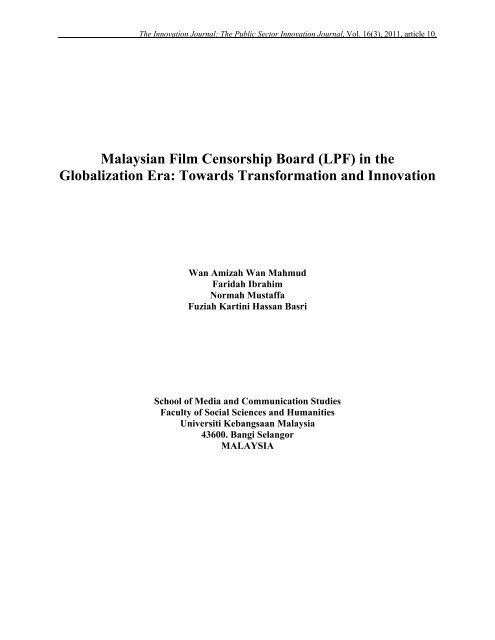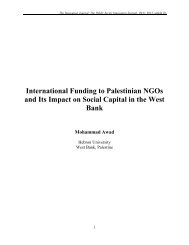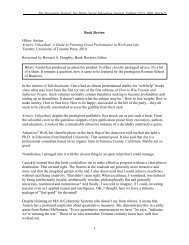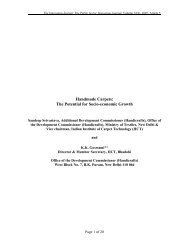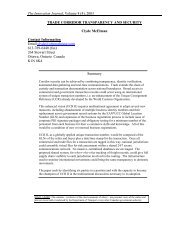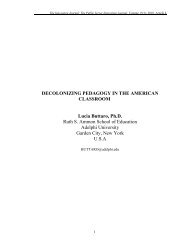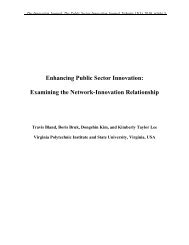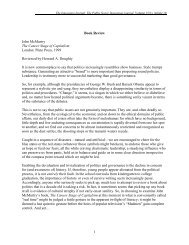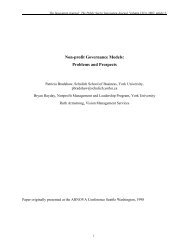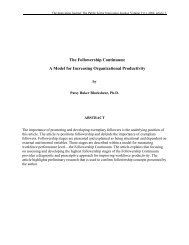Malaysian Film Censorship Board (LPF) in the Globalization Era
Malaysian Film Censorship Board (LPF) in the Globalization Era
Malaysian Film Censorship Board (LPF) in the Globalization Era
You also want an ePaper? Increase the reach of your titles
YUMPU automatically turns print PDFs into web optimized ePapers that Google loves.
The Innovation Journal: The Public Sector Innovation Journal, Vol. 16(3), 2011, article 10.<br />
<strong>Malaysian</strong> <strong>Film</strong> <strong>Censorship</strong> <strong>Board</strong> (<strong>LPF</strong>) <strong>in</strong> <strong>the</strong><br />
<strong>Globalization</strong> <strong>Era</strong>: Towards Transformation and Innovation<br />
Wan Amizah Wan Mahmud<br />
Faridah Ibrahim<br />
Normah Mustaffa<br />
Fuziah Kart<strong>in</strong>i Hassan Basri<br />
School of Media and Communication Studies<br />
Faculty of Social Sciences and Humanities<br />
Universiti Kebangsaan Malaysia<br />
43600. Bangi Selangor<br />
MALAYSIA
The Innovation Journal: The Public Sector Innovation Journal, Vol. 16(3), 2011, article 10.<br />
<strong>Malaysian</strong> <strong>Film</strong> <strong>Censorship</strong> <strong>Board</strong> (<strong>LPF</strong>) <strong>in</strong> <strong>the</strong> <strong>Globalization</strong> <strong>Era</strong>:<br />
Towards Transformation and Innovation<br />
Wan Amizah Wan Mahmud, Faridah Ibrahim,<br />
Normah Mustaffa & Fuziah Kart<strong>in</strong>i Hassan Basri<br />
ABSTRACT<br />
This paper discusses <strong>the</strong> present position of <strong>the</strong> <strong>Film</strong> <strong>Censorship</strong> <strong>Board</strong> (<strong>LPF</strong>), <strong>in</strong> <strong>the</strong> onslaught<br />
of globalization as it strives to <strong>in</strong>terpret and meet <strong>the</strong> government's transformation program on<br />
<strong>the</strong> one hand, while urged <strong>in</strong> a different direction by <strong>the</strong> will and <strong>the</strong> voice of <strong>the</strong> people on <strong>the</strong><br />
o<strong>the</strong>r. To cont<strong>in</strong>ue mov<strong>in</strong>g forward, <strong>the</strong> <strong>LPF</strong> should be look<strong>in</strong>g back for a moment, and <strong>in</strong> order<br />
to learn from history. Lessons from almost a century ago should be <strong>the</strong> guid<strong>in</strong>g framework and<br />
<strong>in</strong>stitution build<strong>in</strong>g to streng<strong>the</strong>n <strong>the</strong> <strong>LPF</strong> for <strong>the</strong> next 100 years. The paper outl<strong>in</strong>es several<br />
measures toward <strong>the</strong> transformation and <strong>in</strong>novation of <strong>the</strong> <strong>LPF</strong>. Despite <strong>the</strong> gratify<strong>in</strong>g<br />
achievements <strong>in</strong> <strong>the</strong> past, <strong>the</strong> <strong>LPF</strong> should execute fur<strong>the</strong>r transformation and <strong>in</strong>novation <strong>in</strong> order<br />
to ensure <strong>the</strong> <strong>Board</strong>’s survival and relevance.<br />
Keywords: film censorship, censorship policy, <strong>Film</strong> <strong>Censorship</strong> <strong>Board</strong>, transformation and<br />
<strong>in</strong>novation<br />
________________________________________________________________________<br />
Introduction<br />
In <strong>the</strong> early 20 th century, a favorite pass-time of watch<strong>in</strong>g movies was considered a form of<br />
popular culture or mass culture that came <strong>in</strong>to existence <strong>in</strong> Malaysia, when films began to<br />
replace bangsawan and <strong>the</strong>ater as a source of enterta<strong>in</strong>ment, especially <strong>in</strong> big cities. British<br />
colonialists who came to Malaya <strong>the</strong>n, equally brought <strong>the</strong>ir culture and <strong>the</strong>ir pass-time of<br />
patroniz<strong>in</strong>g English <strong>the</strong>ater. Hav<strong>in</strong>g <strong>in</strong>troduced films, <strong>the</strong> culture of c<strong>in</strong>ema-go<strong>in</strong>g expanded.<br />
<strong>Film</strong>s were said to be <strong>the</strong> most effective media and capable of spann<strong>in</strong>g all walks of life<br />
compared to o<strong>the</strong>r mass media (G<strong>in</strong>sburg & Roberts 1958). <strong>Film</strong>-watch<strong>in</strong>g <strong>in</strong> popular culture is<br />
considered more prom<strong>in</strong>ent than o<strong>the</strong>r media forms as acceptance of <strong>the</strong> film is more easily<br />
absorbed by <strong>the</strong> pluralistic society with a variety of backgrounds, whe<strong>the</strong>r natives or immigrants<br />
(Desjard<strong>in</strong> 1995).<br />
In <strong>the</strong> early stages, when film came to Malaya, <strong>the</strong> British had yet to impose strict regulations on<br />
c<strong>in</strong>ema operators and film distributors. However, over time, <strong>the</strong> rules and <strong>the</strong> new laws were<br />
gradually <strong>in</strong>troduced to <strong>the</strong> audience and film producers. This <strong>in</strong>fluence, whe<strong>the</strong>r positive or<br />
negative, was absorbed <strong>in</strong>to <strong>the</strong> system, and made censorship policy difficult to remove even<br />
when Malaya ga<strong>in</strong>ed <strong>in</strong>dependence from Brita<strong>in</strong>. The beg<strong>in</strong>n<strong>in</strong>g of <strong>the</strong> film censorship system<br />
and policies emerged from <strong>the</strong> efforts of <strong>the</strong> government, which wanted to control any form of<br />
enterta<strong>in</strong>ment that was shown to <strong>the</strong> people. From controll<strong>in</strong>g and determ<strong>in</strong><strong>in</strong>g what can and<br />
cannot be performed by <strong>the</strong> bangsawan, wayang kulit and Mendu <strong>the</strong>ater, <strong>the</strong>se efforts were<br />
ongo<strong>in</strong>g <strong>in</strong> <strong>the</strong> form of censorship when film arrived <strong>in</strong> Malaya.<br />
Fur<strong>the</strong>r discussion will trace <strong>the</strong> history of censorship <strong>in</strong> Malaysia, with <strong>the</strong> emphasis on<br />
legislation and related policies. Follow<strong>in</strong>g this, we discuss how <strong>the</strong>se past experiences and<br />
lessons can be learnt as we move towards <strong>LPF</strong>’s transformation and <strong>in</strong>novation <strong>in</strong> l<strong>in</strong>e with <strong>the</strong><br />
planned and implemented <strong>in</strong>novation and transformation by <strong>the</strong> government today.<br />
2
The Innovation Journal: The Public Sector Innovation Journal, Vol. 16(3), 2011, article 10.<br />
Look<strong>in</strong>g back<br />
Malaysia is one of <strong>the</strong> few countries <strong>in</strong> <strong>the</strong> world currently practic<strong>in</strong>g film censorship. Malaysia's<br />
censorship policy has gone through a long evolutionary process which began <strong>in</strong>directly from <strong>the</strong><br />
<strong>the</strong>ater, bangsawan and Ch<strong>in</strong>ese Mendu performances (Wan Amizah 2008). The Theatres Act<br />
1895 was enacted more to ensure <strong>the</strong> safety and stage handl<strong>in</strong>g, but early censorship policies<br />
began to be applied when all stage performances were required to obta<strong>in</strong> a license or permit for<br />
<strong>the</strong> performance. <strong>Film</strong>s were orig<strong>in</strong>ally brought to Malaya as a form of enterta<strong>in</strong>ment for British<br />
colonial officers and adm<strong>in</strong>istrators. The earliest legislation relat<strong>in</strong>g to <strong>the</strong> content of film and its<br />
negative impact on <strong>the</strong> audience was <strong>the</strong> Theater Ord<strong>in</strong>ance 1908 (Amendment) Act No. II of<br />
1912 (Straits Settlements). Under this ord<strong>in</strong>ance, <strong>the</strong> police were empowered to determ<strong>in</strong>e what<br />
was appropriate for public show<strong>in</strong>g, and <strong>the</strong>y also raided and seized any unauthorized films.<br />
Appo<strong>in</strong>tment of film censors<br />
The first legislation with a provision for <strong>the</strong> appo<strong>in</strong>tment of film censors under <strong>the</strong> operation of<br />
<strong>the</strong> Police Department was <strong>the</strong> Theater Ord<strong>in</strong>ance 1908 (Amendment) Act No. 22 of 1917 (Straits<br />
Settlements) and <strong>the</strong> Theatre Ord<strong>in</strong>ance 1908 (Amendment) Act No. 1 of 1919 (Straits<br />
Settlements). <strong>Film</strong> censors were specifically appo<strong>in</strong>ted to censor and cut any film prior to a<br />
public show. Promulgation of this appo<strong>in</strong>tment was found <strong>in</strong> <strong>the</strong> Straits Settlement Government<br />
Gazette dated 28 September 1917.<br />
Here began <strong>the</strong> career of a Malayan film censor, by <strong>the</strong> name of Capta<strong>in</strong> T. M. Hussey, a former<br />
British soldier who took office at <strong>the</strong> age of 31, <strong>in</strong> February 3, 1920, earn<strong>in</strong>g £400 a year and for<br />
a three-year contract only. However, <strong>the</strong> contract was subsequently cont<strong>in</strong>ued until his retirement<br />
age of 50 on March 11, 1938, but he appealed to cont<strong>in</strong>ue work<strong>in</strong>g until <strong>the</strong> Second World War.<br />
Hence, <strong>the</strong> policies and system of film censorship <strong>in</strong> Malaya <strong>in</strong> many ways were affected by <strong>the</strong><br />
contribution of Capt. Hussey as a film censor for over 20 years.<br />
Pre-<strong>in</strong>dependence censorship<br />
The first law which dealt specifically with aspects of film control and content was <strong>the</strong><br />
C<strong>in</strong>ematograph <strong>Film</strong>s Ord<strong>in</strong>ance enacted <strong>in</strong> 1924 for <strong>the</strong> Straits Settlements. It was followed by<br />
<strong>the</strong> enactment of <strong>the</strong> C<strong>in</strong>ematograph <strong>Film</strong>s (Control) No. 3 of 1927 for <strong>the</strong> Federated Malay<br />
States and Johore. On 18 September, 1926, The Times published an article by Sir Hesketh Bell<br />
entitled “The C<strong>in</strong>ema <strong>in</strong> <strong>the</strong> East: Factor <strong>in</strong> <strong>the</strong> Spread of Communism.” It caught <strong>the</strong> attention of<br />
K<strong>in</strong>g George V, <strong>the</strong> grandfa<strong>the</strong>r of Queen Elizabeth II, who ruled Brita<strong>in</strong> and <strong>the</strong> colonies. It<br />
soon became a catalyst for change <strong>in</strong> <strong>the</strong> censorship system and policy <strong>in</strong> Malaya. The K<strong>in</strong>g was<br />
concerned that “perhaps th<strong>in</strong>gs [had] gone too far for <strong>in</strong>tervention to be of any avail (CO<br />
273/533/18384); none<strong>the</strong>less, he ordered that <strong>the</strong> Colonial Office <strong>in</strong>vestigate <strong>the</strong> allegations that<br />
films tarnished <strong>the</strong> image of <strong>the</strong> West. The government <strong>in</strong> S<strong>in</strong>gapore denied <strong>the</strong> allegations, but<br />
<strong>in</strong>sisted that <strong>the</strong> regulations were very strict and even received compla<strong>in</strong>ts from <strong>the</strong> British film<br />
<strong>in</strong>dustry, but a clear message had been sent.<br />
The film censorship scenario was cont<strong>in</strong>ued by <strong>the</strong> British <strong>in</strong> accordance with <strong>the</strong> pr<strong>in</strong>ciples and<br />
framework of British philosophy, but at <strong>the</strong> outbreak of World War II and <strong>the</strong> Japanese<br />
Occupation of Malaya and S<strong>in</strong>gapore, all rules were at a standstill. Instead, Japan brought <strong>the</strong>ir<br />
pr<strong>in</strong>ciples and rules of <strong>the</strong>ir own: all movies from <strong>the</strong> West were totally banned and only<br />
Japanese films and a few Asian films were allowed. Fur<strong>the</strong>rmore, all c<strong>in</strong>emas were taken over by<br />
3
The Innovation Journal: The Public Sector Innovation Journal, Vol. 16(3), 2011, article 10.<br />
Japanese companies and turned <strong>in</strong>to Japanese government agency headquarters. In fact, due to<br />
<strong>the</strong> Japanese Occupation, all Malay film productions were also stopped, and only resumed<br />
productions after <strong>the</strong> Japanese were defeated and <strong>the</strong> British returned to rule.<br />
The establishment of <strong>the</strong> film censorship board<br />
The first Act that was enacted specifically to address aspects of film censorship <strong>in</strong> Malaya was<br />
<strong>the</strong> C<strong>in</strong>ematograph <strong>Film</strong>s Ord<strong>in</strong>ance of 1952. The <strong>Film</strong> <strong>Censorship</strong> <strong>Board</strong> (<strong>LPF</strong>) was established<br />
<strong>in</strong> 1954, by a committee <strong>in</strong> S<strong>in</strong>gapore for <strong>the</strong> Straits Settlements, and a committee <strong>in</strong> Kuala<br />
Lumpur for Malaya (Federated Malay States and <strong>the</strong> Unfederated Malay States). <strong>Censorship</strong> was<br />
no longer done by a s<strong>in</strong>gle censor, but by a committee of three members. The enforcement of<br />
film censorship also transferred from <strong>the</strong> jurisdiction of <strong>the</strong> Police Inspector General to <strong>the</strong><br />
M<strong>in</strong>ister of Home Affairs <strong>in</strong> 1952.<br />
<strong>Film</strong> classification was <strong>in</strong>troduced <strong>in</strong> 1953, which allocated films <strong>in</strong>to one of two categoroes: for<br />
Adults Only and for General View<strong>in</strong>g. The withdrawal of S<strong>in</strong>gapore from Malaysia <strong>in</strong> 1965<br />
created an impact too because all this while, <strong>the</strong> headquarters of <strong>the</strong> film censors was based <strong>in</strong><br />
S<strong>in</strong>gapore. The name C<strong>in</strong>ematograph <strong>Film</strong>s Ord<strong>in</strong>ance of 1952 was <strong>the</strong>n changed to <strong>the</strong><br />
C<strong>in</strong>ematograph <strong>Film</strong>s Act <strong>in</strong> 1966. Later, <strong>the</strong> <strong>Malaysian</strong> <strong>Film</strong> <strong>Censorship</strong> <strong>Board</strong> was established<br />
<strong>in</strong> 1966 to implement policies and censorship system for <strong>the</strong> whole of Malaysia, <strong>in</strong>clud<strong>in</strong>g Sabah<br />
and Sarawak.<br />
Liberalization of <strong>the</strong> censorship policy<br />
The year 1971 was ano<strong>the</strong>r historic moment <strong>in</strong> film censorship when, for <strong>the</strong> first time,<br />
classification of films for Adults, or sex films, was <strong>in</strong>troduced <strong>in</strong> all c<strong>in</strong>emas. This angered <strong>the</strong><br />
people and, on <strong>the</strong> recommendation of <strong>the</strong> Select Parliamentary Committee on Questionable<br />
<strong>Film</strong>s <strong>in</strong> 1972, all X-rated films were banned. A classification system was amended <strong>in</strong> 1996 to<br />
<strong>in</strong>clude programs and movies broadcast on television and video. At <strong>the</strong> turn of <strong>the</strong> century, a new<br />
act was <strong>in</strong>troduced, <strong>the</strong> <strong>Film</strong> <strong>Censorship</strong> Act 2002, to address more specifically <strong>the</strong> control and<br />
censorship of <strong>in</strong>creas<strong>in</strong>gly sophisticated and challeng<strong>in</strong>g technology tools.<br />
Accord<strong>in</strong>g to Ernst and Seagle (1969), a perfect film censor does not exist <strong>in</strong> this world. Each<br />
person is bound by knowledge and experiences that are not visible to <strong>the</strong> naked eye. Decision<br />
mak<strong>in</strong>g and personal philosophies are <strong>in</strong>evitable because, whe<strong>the</strong>r a film is approved with cuts or<br />
banned, everyth<strong>in</strong>g dependes on <strong>the</strong>ir socio-cultural values. Censors made personal decisions<br />
despite given certa<strong>in</strong> guidel<strong>in</strong>es.<br />
Transformation<br />
Prime M<strong>in</strong>ister Najib Tun Razak <strong>in</strong>troduced <strong>the</strong> Government Transformation Plan (GTP) <strong>in</strong><br />
April 2009. Under this plan, <strong>the</strong> entire government mach<strong>in</strong>ery has to be transformed to meet two<br />
ma<strong>in</strong> objectives: firstly, to be more effective <strong>in</strong> service delivery through several key result areas,<br />
and secondly to drive Malaysia towards a progressive, <strong>in</strong>tegrated and equitable society with a<br />
high standard of liv<strong>in</strong>g for all. These objectives are consistent with <strong>the</strong> national mission of<br />
achiev<strong>in</strong>g Vision 2020, i.e. mak<strong>in</strong>g Malaysia a fully developed country by <strong>the</strong> year 2020. Thus,<br />
six National Key Result Areas (NKRA) have been identified to move towards <strong>the</strong> transformation<br />
of government, namely:<br />
4
The Innovation Journal: The Public Sector Innovation Journal, Vol. 16(3), 2011, article 10.<br />
a) Reduc<strong>in</strong>g crime<br />
b) Combat<strong>in</strong>g corruption<br />
c) Improv<strong>in</strong>g student outcomes<br />
d) Rais<strong>in</strong>g liv<strong>in</strong>g standards of low <strong>in</strong>come households<br />
e) Improv<strong>in</strong>g basic rural <strong>in</strong>frastructure<br />
f) Improv<strong>in</strong>g urban public transport<br />
In this case, <strong>the</strong> <strong>LPF</strong>, under <strong>the</strong> jurisdiction of <strong>the</strong> M<strong>in</strong>istry of Home Affairs, may be associated<br />
<strong>in</strong>directly with only one NKRA, i.e. reduc<strong>in</strong>g crime. The essence of <strong>the</strong> M<strong>in</strong>istry’s effort is to<br />
fight crime, <strong>in</strong>clud<strong>in</strong>g <strong>the</strong> reduction of crime <strong>in</strong>dex with a focus on street crime, to improve<br />
public perception of safety, and to enhance <strong>the</strong> performance of <strong>the</strong> justice system.<br />
Therefore, <strong>the</strong> duties and responsibilities of <strong>the</strong> <strong>LPF</strong> are not associated directly with NKRA. If<br />
<strong>the</strong>re is any <strong>in</strong>direct connection, it may be to <strong>the</strong> first NKRA, i.e. reduc<strong>in</strong>g crime; however, this<br />
can only be ascerta<strong>in</strong>ed if fur<strong>the</strong>r studies prove that uncensored film lead to street crime or o<strong>the</strong>r<br />
acts of violence.<br />
Transformation at <strong>the</strong> <strong>Film</strong> <strong>Censorship</strong> <strong>Board</strong> (<strong>LPF</strong>) level<br />
The <strong>LPF</strong>, however, may attempt a transformation at <strong>the</strong> organization level. The transformation<br />
should be done <strong>in</strong> a holistic and <strong>in</strong>tegrated manner, and <strong>the</strong>re must be some steps or process<br />
related to it. Transformation is usually done when <strong>the</strong>re is a specific trigger or a compell<strong>in</strong>g need<br />
to make <strong>the</strong> transformation. For example, when <strong>the</strong>re are <strong>in</strong>structions from superiors who want a<br />
reform to be put <strong>in</strong> place. However, at present, <strong>the</strong>re are no specific <strong>in</strong>structions for <strong>the</strong> <strong>LPF</strong>; so,<br />
no proposed transformation is yet a major one.<br />
Rebrand<strong>in</strong>g of <strong>the</strong> <strong>Film</strong> <strong>Censorship</strong> <strong>Board</strong> (<strong>LPF</strong>)<br />
This paper proposes <strong>the</strong> first transformation to be done by <strong>the</strong> <strong>LPF</strong> is rebrand<strong>in</strong>g by chang<strong>in</strong>g <strong>the</strong><br />
name of <strong>the</strong> <strong>Board</strong>. The first censor was appo<strong>in</strong>ted <strong>in</strong> 1917, thus by 2017, it would be 100 years<br />
of film censorship <strong>in</strong> Malaysia. However, <strong>the</strong> task of film censorship has its ups and downs. In<br />
any country <strong>in</strong> <strong>the</strong> world, <strong>the</strong> words “censor” and “censorship” are no longer accepted positively.<br />
Even <strong>in</strong> Malaysia, <strong>the</strong>re are those who view <strong>LPF</strong> with <strong>the</strong> connotation of a savage or a scary<br />
monster.<br />
Therefore, <strong>the</strong> proposed rebrand<strong>in</strong>g exercise here is that <strong>the</strong> name of <strong>the</strong> <strong>Film</strong> <strong>Censorship</strong> <strong>Board</strong><br />
to be changed to <strong>the</strong> <strong>Film</strong> Classification Council or <strong>the</strong> <strong>Board</strong> of <strong>Film</strong> Classification.<br />
Conceptually, <strong>the</strong> task of <strong>the</strong> <strong>LPF</strong> is to classify films, thus <strong>the</strong> censor<strong>in</strong>g function is still be<strong>in</strong>g<br />
done, though not reflected <strong>in</strong> <strong>the</strong> name. In fact, many countries, such as Brita<strong>in</strong>, <strong>the</strong> United<br />
States, Australia, Canada and Ireland, use <strong>Board</strong> of <strong>Film</strong> Classification to name <strong>the</strong> organization<br />
with this function.<br />
Adjust<strong>in</strong>g <strong>the</strong> Membership Composition<br />
The membership composition of <strong>the</strong> <strong>LPF</strong> is currently very much skewed towards male<br />
dom<strong>in</strong>ation and an older age group. Out of 74 current <strong>LPF</strong> members, only 10 or 13.5% are<br />
female, (as at 30 th June 2011). The composition accord<strong>in</strong>g to age group is also high, that is, above<br />
60 years old, and a large majority of <strong>the</strong> members are government pensioners from various<br />
5
The Innovation Journal: The Public Sector Innovation Journal, Vol. 16(3), 2011, article 10.<br />
departments and agencies. This paper proposes that <strong>the</strong> composition should be at least 30 to 40%<br />
female and at least 50% of <strong>the</strong> members should be younger than 50 years of age.<br />
Innovation<br />
Innovation has been given many operational def<strong>in</strong>itions (Glor 2008). In <strong>the</strong> context of this paper,<br />
<strong>in</strong>novation is def<strong>in</strong>ed as <strong>the</strong> <strong>in</strong>troduction and implementation of any new policy, process or<br />
program by any organization. Thus, given <strong>the</strong> proposed transformation above, <strong>the</strong> paper proposes<br />
that <strong>the</strong> <strong>LPF</strong> should be more proactive and <strong>in</strong>novative <strong>in</strong> implement<strong>in</strong>g new strategies, as<br />
discussed below.<br />
<strong>Censorship</strong> <strong>Board</strong> Members are skilled human capital<br />
An early approach <strong>in</strong> <strong>the</strong> <strong>in</strong>novation strategy is to view <strong>Censorship</strong> <strong>Board</strong> members from <strong>the</strong><br />
perspective of <strong>the</strong> skilled human capital who take apply a sense of <strong>in</strong>tegrity to <strong>the</strong>ir<br />
responsibilities. Thus, this will change <strong>the</strong> public perception that members of <strong>the</strong> <strong>Censorship</strong><br />
<strong>Board</strong> are merely “moral police” (Murat, 2006). The task of <strong>the</strong> <strong>LPF</strong> <strong>in</strong> censor<strong>in</strong>g films requires<br />
a specialized skill. In <strong>the</strong> application form to be a member of <strong>LPF</strong>, <strong>the</strong> ma<strong>in</strong> characteristics<br />
required are:<br />
a) Extensive experience <strong>in</strong> areas such as adm<strong>in</strong>istration, management, teach<strong>in</strong>g, religious,<br />
enforcement, military, broadcast<strong>in</strong>g and o<strong>the</strong>r appropriate fields;<br />
b) Skills <strong>in</strong> various languages;<br />
c) Ability to write reports <strong>in</strong> good Malay;<br />
d) Knowledge of <strong>the</strong> film and enterta<strong>in</strong>ment <strong>in</strong>dustry;<br />
e) The right attitude toward <strong>the</strong> duties of office, an open m<strong>in</strong>d and <strong>the</strong> high analytical skills.<br />
Hence, <strong>the</strong> duties and responsibilities of a new member of <strong>the</strong> <strong>LPF</strong> require multiskill<strong>in</strong>g and<br />
special personality as a prerequisite.<br />
Creat<strong>in</strong>g Key Performance Indicator (KPI) for <strong>LPF</strong> as a Group and an Individual<br />
Although members of <strong>the</strong> <strong>LPF</strong> are not permanent civil servants, <strong>the</strong>ir duties and functions are <strong>in</strong><br />
l<strong>in</strong>e with <strong>the</strong> aspirations and needs of <strong>the</strong> government. Thus, <strong>the</strong> <strong>LPF</strong> can build a set of KPIs that<br />
can be applied <strong>in</strong>ternally, <strong>in</strong>clud<strong>in</strong>g assessment and evaluation as a group and as an <strong>in</strong>dividual<br />
member.<br />
In <strong>the</strong> GTP for Phase 3 (2015-2020), Malaysia plans to reduce <strong>the</strong> size of government as part of<br />
Gross Domestic Product, and to <strong>in</strong>crease <strong>the</strong> role of <strong>the</strong> private sector <strong>in</strong> provid<strong>in</strong>g public<br />
services. Therefore, it is possible that one day <strong>the</strong> <strong>LPF</strong> will have its status changed from <strong>the</strong><br />
current policy as an <strong>in</strong>stitution or agency that is under <strong>the</strong> jurisdiction of <strong>the</strong> M<strong>in</strong>istry of Home<br />
Affairs, to a private entity, but provid<strong>in</strong>g <strong>the</strong> same services to <strong>the</strong> M<strong>in</strong>istry.<br />
6
The Innovation Journal: The Public Sector Innovation Journal, Vol. 16(3), 2011, article 10.<br />
Collaborat<strong>in</strong>g Efforts of Media Literacy with <strong>Film</strong> Control Division, MOHA<br />
The <strong>Film</strong> <strong>Censorship</strong> Control and Enforcement Division (BKF) of <strong>the</strong> M<strong>in</strong>istry of Home Affairs<br />
(MOHA), which is <strong>the</strong> secretariat and trustworthy associate to <strong>the</strong> <strong>LPF</strong> over <strong>the</strong> years, is stepp<strong>in</strong>g<br />
up efforts to promote prevention education programs at all levels of society. In fact, <strong>the</strong> BKF<br />
launched a prevention education program at <strong>the</strong> M<strong>in</strong>istry of Home Affairs Complex, Ayer Keroh<br />
Melaka on December 10, 2010. A series of lectures for schools, campaigns, road shows and<br />
media appearances are be<strong>in</strong>g held <strong>in</strong> this program. The <strong>LPF</strong> also works toge<strong>the</strong>r to give lectures<br />
to <strong>the</strong> public. This effort is commendable and should be cont<strong>in</strong>ued <strong>in</strong> <strong>the</strong> future.<br />
Prevention education, however, is part of media literacy. Media literacy is def<strong>in</strong>ed as skills to<br />
access, appreciate, <strong>in</strong>terpret, analyze, produce and evaluate a message <strong>in</strong> all its forms and formats<br />
of media, whe<strong>the</strong>r pr<strong>in</strong>t or digital media (National Communication Association, 1998).<br />
Therefore, media literacy <strong>in</strong> terms of film censorship is <strong>the</strong> skill to watch a film and be able to<br />
<strong>in</strong>terpret, analyze and evaluate media messages critically as well as <strong>the</strong> ability to choose content<br />
which is “good” or o<strong>the</strong>rwise.<br />
Therefore, media literacy is much more than just prevention. An example that can be compared<br />
to preventive education is to teach children to choose books based on its cover. If <strong>the</strong>re are no<br />
specific labels on <strong>the</strong> cover, do not buy. However, for media literacy, we do not simply teach<br />
children to read books, but we encourage <strong>the</strong>m to th<strong>in</strong>k whe<strong>the</strong>r <strong>the</strong> content of <strong>the</strong> book is<br />
suitable for <strong>the</strong>m. In some countries, <strong>the</strong>re are media literacy education modules for children,<br />
e.g., one module for primary schools and one for secondary schools.<br />
Us<strong>in</strong>g social media to <strong>in</strong>form and receive feedback<br />
Ano<strong>the</strong>r <strong>in</strong>novation which could be easily implemented is us<strong>in</strong>g social media to <strong>in</strong>form and<br />
receive feedback from <strong>the</strong> film community or audiences. Among <strong>the</strong> most popular social media<br />
<strong>in</strong> Malaysia are Facebook and Twitter, which even Prime M<strong>in</strong>ister Najib Tun Razak widely uses<br />
<strong>in</strong> his daily rout<strong>in</strong>e.<br />
Social media for <strong>the</strong> government sector generally has a three-pronged approach: to <strong>in</strong>form about<br />
policies to target stakeholders, to ga<strong>the</strong>r feedback regard<strong>in</strong>g any proposed or implemented<br />
policies and to assess reactions of stakeholder op<strong>in</strong>ions (Lampe et al. 2011). However, Lampe et<br />
al. (2011) also cautioned that “social media projects designed to <strong>in</strong>teract with <strong>the</strong> public can be<br />
<strong>in</strong>itiated with reasonable expectations, yet be hard to implement due to a range of limitations<br />
imposed by social, technical and task dependencies”.<br />
Support<strong>in</strong>g grassroots <strong>in</strong>itiatives to promote research and development<br />
The <strong>Film</strong> <strong>Censorship</strong> Control and Enforcement Division of <strong>the</strong> M<strong>in</strong>istry of Home Affairs and<br />
<strong>LPF</strong> should be partners <strong>in</strong> support<strong>in</strong>g research and development. Useful <strong>in</strong>put as well as<br />
cooperation and support from members of <strong>the</strong> <strong>LPF</strong> are required to build <strong>the</strong> resources of<br />
literature <strong>in</strong> film censorship, ei<strong>the</strong>r from social aspects or technical aspects. Indeed, <strong>the</strong>re is gap<br />
<strong>in</strong> <strong>the</strong> fields of censorship studies <strong>in</strong> Malaysia and any help from <strong>LPF</strong> is much needed, especially<br />
for university researchers. Any grassroots-level <strong>in</strong>itiatives and bottom-up efforts, <strong>in</strong> this case <strong>the</strong><br />
application for research, should be supported to ensure <strong>the</strong> success of <strong>the</strong> application (Antal<br />
2010).<br />
7
The Innovation Journal: The Public Sector Innovation Journal, Vol. 16(3), 2011, article 10.<br />
Align<strong>in</strong>g strategies to support <strong>the</strong> National Key Results Area (NKRA) of M<strong>in</strong>istry of Home<br />
Affairs<br />
With <strong>the</strong> launch of <strong>the</strong> Government Transformation Program, each m<strong>in</strong>istry and <strong>the</strong> M<strong>in</strong>ister<br />
have <strong>the</strong>ir own KPIs to be met and reported responsibly. In <strong>the</strong> NKRA Report announced <strong>in</strong><br />
March 2011, <strong>the</strong> Home M<strong>in</strong>istry’s NKRA is subjected to <strong>the</strong> duties and powers of <strong>the</strong> Royal<br />
<strong>Malaysian</strong> Police Force, i.e. <strong>the</strong> prevention of crime. However, <strong>the</strong> <strong>LPF</strong> may devise appropriate<br />
strategies as a preparation to support <strong>the</strong> M<strong>in</strong>istry’s NKRA <strong>in</strong> <strong>the</strong> near future.<br />
Benefitt<strong>in</strong>g from globalization and technological advancement<br />
This strategy is also consistent with <strong>the</strong> Strategic Thrust of <strong>the</strong> Home M<strong>in</strong>istry's 2010 Integrity<br />
Plan which wants to expand <strong>the</strong> use of ICT. One example of software development which is now<br />
used by <strong>the</strong> <strong>LPF</strong> is <strong>the</strong> E-Filem portal featur<strong>in</strong>g <strong>LPF</strong> censorship decisions. These are <strong>in</strong>novative<br />
and creative efforts. This service is currently used by <strong>the</strong> M<strong>in</strong>istry officials, and film-related<br />
television staff.<br />
The <strong>in</strong>formation-seek<strong>in</strong>g process can be aided too by advances <strong>in</strong> ICT. For example, if <strong>the</strong>re is<br />
confusion concern<strong>in</strong>g a term<strong>in</strong>ology or slang word, <strong>the</strong> Internet can be used as reference to<br />
ensure that <strong>the</strong> mean<strong>in</strong>g of <strong>the</strong> word is not aga<strong>in</strong>st any film censorship guidel<strong>in</strong>es.<br />
<strong>Film</strong> censorship as a basic social contract and a tool of <strong>in</strong>tegration<br />
In <strong>the</strong> <strong>Malaysian</strong> context, <strong>the</strong> social contract is a mutual agreement among <strong>the</strong> leaders of <strong>the</strong><br />
various races <strong>in</strong> determ<strong>in</strong><strong>in</strong>g <strong>the</strong> direction of <strong>the</strong> country dur<strong>in</strong>g <strong>the</strong> era of <strong>in</strong>dependence. It is<br />
seen as a s<strong>in</strong>cere collaboration that <strong>in</strong>volves racial tolerance. The draft<strong>in</strong>g of <strong>the</strong> Federation of<br />
Malaya Constitution <strong>in</strong> 1957 took <strong>in</strong>to account <strong>the</strong> tolerance and cooperation between people of<br />
different races. This social contract consists of two elements, first, <strong>the</strong> acceptance of <strong>the</strong> Malays<br />
aga<strong>in</strong>st <strong>the</strong> non-Malay populations as citizens 'jus soli' for <strong>the</strong> newly <strong>in</strong>dependent country and,<br />
second, <strong>the</strong> acceptance of non-Malays aga<strong>in</strong>st <strong>the</strong> recognition of special rights and <strong>in</strong>terests of<br />
<strong>the</strong> Malays <strong>in</strong> <strong>the</strong> country.<br />
Never<strong>the</strong>less, <strong>the</strong> social contract is often manipulated by politicians for <strong>the</strong>ir own political<br />
survival. Such actions have created a number of problems which are complex and often lead to<br />
stra<strong>in</strong>ed relations between <strong>the</strong> races. Thus <strong>the</strong> social contract is still ensconced <strong>in</strong> all sorts of<br />
controversy due to a pattern of racial politics that is too constricted. Accord<strong>in</strong>g to John Locke<br />
(1960), <strong>the</strong>re are three parties <strong>in</strong> a social contract, i.e., <strong>the</strong> trustor, <strong>the</strong> trustee and <strong>the</strong> beneficiary.<br />
In this case, film as a platform reflect<strong>in</strong>g <strong>the</strong> reality of society and culture can play a role <strong>in</strong> <strong>the</strong><br />
context of unity <strong>in</strong> Malaysia. <strong>Film</strong>s which can confuse <strong>the</strong> unity of <strong>the</strong> people must be censored<br />
to prevent tension <strong>in</strong> a plural society like Malaysia.<br />
Conclusion<br />
In Malaysia, film is considered <strong>the</strong> arm of government, and <strong>the</strong>refore it must function <strong>in</strong><br />
accordance with government requirements (Kart<strong>in</strong>i & Alaudd<strong>in</strong> 2003). Should <strong>the</strong> film be found<br />
to contradict or oppose <strong>the</strong> policies and aspirations of <strong>the</strong> current government, <strong>the</strong>n <strong>the</strong> film<br />
should be censored or banned for public display. In this paper, historical recollection of<br />
censorship policies is used as <strong>the</strong> guid<strong>in</strong>g framework for future policy considerations. It fur<strong>the</strong>r<br />
outl<strong>in</strong>es several transformation and <strong>in</strong>novation programs for <strong>the</strong> <strong>Film</strong> <strong>Censorship</strong> <strong>Board</strong> and <strong>the</strong><br />
<strong>Malaysian</strong> Government to ensure <strong>the</strong> survival and relevancy of <strong>the</strong> <strong>Board</strong>.<br />
8
The Innovation Journal: The Public Sector Innovation Journal, Vol. 16(3), 2011, article 10.<br />
Acknowledgement<br />
This project was funded by UKM-SK-05-FRGS0171-2010<br />
About <strong>the</strong> Authors:<br />
Dr. Wan Amizah Wan Mahmud is currently a senior lecturer at <strong>the</strong> School of Media and<br />
Communication Studies, Faculty of Social Sciences and Humanities, Universiti Kebangsaan<br />
Malaysia. Her research <strong>in</strong>terests <strong>in</strong>clude film censorship, communication policies, broadcast<strong>in</strong>g<br />
system, communication of at-risk youths, and subtitl<strong>in</strong>g. She can be contacted at<br />
wan_amizah@ukm.my<br />
Dr. Faridah Ibrahim is an associate professor at <strong>the</strong> School of Media and Communication<br />
Studies, Faculty of Social Sciences and Humanities, Universiti Kebangsaan Malaysia. Her<br />
research <strong>in</strong>terests <strong>in</strong>clude journalism and media ethics. She can be contacted at fbi@ukm.my<br />
Dr. Normah Mustaffa is currently Chair of <strong>the</strong> School of Media and Communication Studies,<br />
Faculty of Social Sciences and Humanities, Universiti Kebangsaan Malaysia. Her research<br />
<strong>in</strong>terests <strong>in</strong>clude journalism and social media. She can be contacted at normahm@ukm.my<br />
Fuziah Kart<strong>in</strong>i Hassan Basri is an associate professor at <strong>the</strong> School of Media and<br />
Communication Studies, Faculty of Social Sciences and Humanities, Universiti Kebangsaan<br />
Malaysia. Her research <strong>in</strong>terests <strong>in</strong>clude development communication and gender studies. She<br />
can be contacted at fuziah@ukm.my<br />
References:<br />
Antal, M. 2010. “Applications for Official Support – An Innovative Way to Promote Grassroots<br />
Initiatives.” The Innovation Journal: The Public Sector Innovation Journal, 15(2), article 6.<br />
Retrieved December 27, 2011 from www.<strong>in</strong>novation.cc/volumes-issues/vol15-no2.htm.<br />
Basri, F. & R. Alaudd<strong>in</strong>. 2003. “The Search for a <strong>Malaysian</strong> C<strong>in</strong>ema: Between U-Wei Shaari,<br />
Shuhaimi, Yusof and <strong>LPF</strong>M.” In Isu-isu komunikasi, edited by S. A. Rahim, Bangi, Malaysia:<br />
School of Media and Communication Studies, Universiti Kebangsaan Malaysia.<br />
Bell, H. 1926. “The C<strong>in</strong>ema <strong>in</strong> <strong>the</strong> East: Factor <strong>in</strong> <strong>the</strong> Spread of Communism.” The Times, 18<br />
September.<br />
Desjard<strong>in</strong>, M. 1995. “C<strong>in</strong>ema and Communication.” Pp. 394-412 <strong>in</strong> Down<strong>in</strong>g J, A. Mohammadi<br />
& A. Sreberny-Mohammadi. (Eds.). Question<strong>in</strong>g <strong>the</strong> Media: A Critical Introduction. Thousand<br />
Oaks: Sage Publications.<br />
Ernst, M. & W. Seagle. 1969. To <strong>the</strong> Pure: A Study of Obscenity and <strong>the</strong> Censor. New York:<br />
Vik<strong>in</strong>g.<br />
G<strong>in</strong>sburg, N. & C. Roberts. 1958. Malaya. Seattle: University of Wash<strong>in</strong>gton Press.<br />
9
The Innovation Journal: The Public Sector Innovation Journal, Vol. 16(3), 2011, article 10.<br />
Glor, E. 2008. “Toward Development of a Substantive Theory of Public Service Organizational<br />
Innovation.” The Innovation Journal: The Public Sector Innovation Journal, 13(3), article 6.<br />
Retrieved December 27, 2011 from www.<strong>in</strong>novation.cc/volumes-issues/vol13-no3.htm<br />
Lampe, C., R. LaRose, C. Ste<strong>in</strong>field. & K. DeMaagd. 2011. “Inherent Barriers to <strong>the</strong> Use of<br />
Social Media for Public Policy Informatics.” The Innovation Journal: The Public Sector<br />
Innovation Journal, 16(1), article 6. Retrieved December 27, 2011 from<br />
www.<strong>in</strong>novation.cc/volumes-issues/vol16-no1.htm<br />
Locke, J. 1960. An Essay Concern<strong>in</strong>g <strong>the</strong> True Orig<strong>in</strong>al, Extent and End of Civil Government <strong>in</strong><br />
Social Contract. Oxford, UK: Oxford University Press. (Orig<strong>in</strong>al work published 1690).<br />
Murat, M. J. 2006. “Filem Melayu atau Malaysia?” M<strong>in</strong>gguan Malaysia, May 14.<br />
National Communication Association. 1998. K-12 Speak<strong>in</strong>g, Listen<strong>in</strong>g, and Media Literacy<br />
Standards and Competency Statements. Wash<strong>in</strong>gton, D.C.: National Communication<br />
Association.<br />
Prime M<strong>in</strong>ister's Office. 2010. Government Transformation Program. Kuala Lumpur. Malaysia.<br />
(See also: Press Release -<br />
http://www.pmo.gov.my/?menu=newslist&news_id=58&page=1731&news_cat=13.)<br />
Wan Amizah Wan Mahmud. 2008. “The Evolution and Development of <strong>Film</strong> <strong>Censorship</strong><br />
Systems and Policies <strong>in</strong> Malaysia.” PhD diss. Universiti Kebangsaan Malaysia.<br />
10


